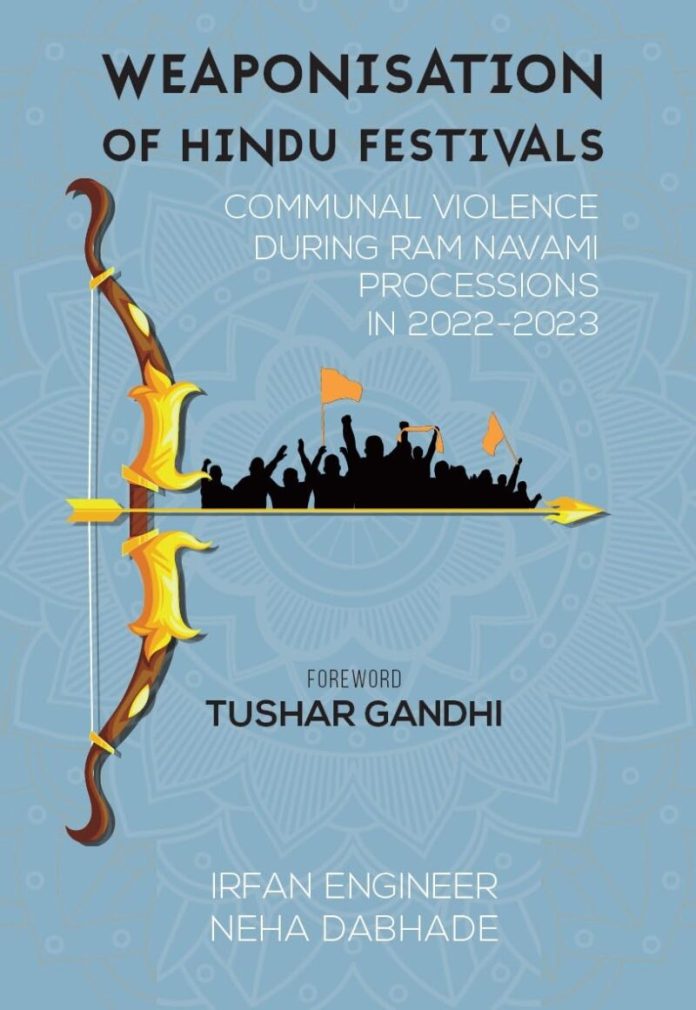Authored by Advocate Irfan Engineer, Director of the Centre for Study of Society and Secularism (CSSS), and Neha Dabhade, Executive Director of CSSS, Weaponisation of Hindu Festivals is a crucial exploration of how Hindu festivals, particularly Ram Navami, have been increasingly used as tools of hate and intimidation against Muslims. Published by Pharos Media, this book sheds light on the alarming trend of violence and societal polarisation instigated during religious celebrations.
The book focuses on incidents of communal violence associated with Ram Navami processions in 2022 and 2023. It documents a series of violent episodes in various locations, including Howrah and Hooghly, Sambhaji Nagar, Vadodara, Biharsharif, Sasaram, Khargone, Himmat Nagar, Khambat, and Lohardagga. Through detailed analysis, the authors examine the mechanisms that have transformed what were once joyous festivals into platforms for aggressive displays of power and intimidation.
The authors reveal a disturbing pattern:
– Provocative Routes: Processions deliberately deviating from agreed or permitted paths to pass through Muslim-dominated areas.
– Show of Force: Participants openly carrying weapons and blaring loud, provocative music near mosques, often timed to disrupt prayers.
– Sloganeering and Prepared Violence: Aggressive chants insulting Muslims and readiness to retaliate violently against any objections.
The book highlights how these processions often target impartial police officers, pressuring them to either align with the aggressors or face punitive actions like transfers. This trend, the authors argue, undermines the secular fabric of the state and intensifies communal tensions.
In Introduction, Irfan Engineer points to the complicity or negligence of the state, describing how minority communities are disproportionately punished. He writes:
“A small group of Hindu nationalists, disguised as a ‘religious procession,’ may insist on traversing areas predominantly inhabited by minorities, inciting local youth with political slogans and aggressive music. The state often responds by detaining numerous minority members and demolishing their homes without due judicial process.”
The book calls on the state to take decisive action against such orchestrated violence. It emphasises the importance of enforcing existing laws to prevent the carrying of weapons and the playing of provocative music during processions.
The authors suggest a multi-pronged approach to counter this rising trend:
- Strict Regulation: Prohibit the display of weapons and the use of inflammatory music or slogans during religious processions.
- Legal Action: Investigate and prosecute those inciting hatred or participating in violence, ensuring due process.
- Community Building: Foster interfaith harmony through cultural programs, films, and initiatives that promote peace and unity.
- Victim Support: Provide compensation to victims of communal violence and work towards rebuilding trust within communities.
In Foreword, Tushar Gandhi underscores the urgency of revisiting Gandhian principles to combat the rising tide of hate. He emphasises the need to propagate messages of nonviolence and communal harmony to restore societal sanity.
Weaponisation of Hindu Festivals is not just an exposé of rising communalism but a call to safeguard the sanctity of religious celebrations. It urges citizens and the state alike to resist the distortion of festivals into platforms for hate, advocating instead for their use as opportunities to strengthen societal bonds.




